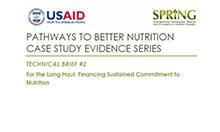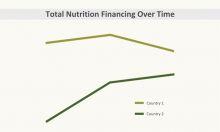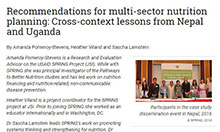Understanding How Policy Translates into Action
A multi-sectoral approach is often thought to be the most effective way to address undernutrition.
Good governance and policy can create momentum for improved nutrition. But how can countries best move from good nutrition policy to improved nutrition outcomes? SPRING’s Pathways to Better Nutrition Case Studies provide new evidence to help countries understand how nutrition-related activities are prioritized and funded, focusing on the effect that national nutrition action plans have on these processes in two different contexts: Uganda and Nepal.
Having a nutrition action plan is an important first step; however, a plan alone will not achieve nutrition goals at scale. To translate the high-level commitment signaled in a national action plan into new activities and increased funding, nutrition must be prioritized by the relevant ministries, local governments, and external partners. These case studies test whether national nutrition action plans in Uganda and Nepal improved the prioritization of nutrition during work planning, which in turn increased funding for nutrition over the course of the study’s tenure. Through this process, we identified several concrete drivers of change in the prioritization and funding for nutrition and developed a list of recommendations to help countries maximize the impact of their national nutrition action plans.






















